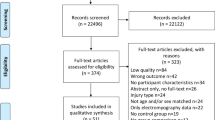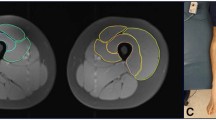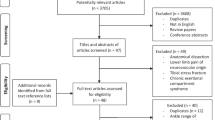Abstract
Background
Dysfunction of the tensor fascia latae (TFL) muscle is often clinically implicated in many musculoskeletal disorders.
Objective
To systematically review the literature of the TFL muscle to determine whether there are differences in its structure and activation between individuals with and without lower limb musculoskeletal conditions.
Data sources
A comprehensive search in MEDLINE, EMBASE, CINHAL, and LILACS was undertaken from year of inception to 9 July 2019.
Eligibility criteria for selecting studies
Studies that directly investigated the structure or activity of the TFL muscle between individuals with a lower limb musculoskeletal condition and a pain-free control group.
Results
Seventeen studies were included (n = 556 participants), eight reporting structure and ten activation of the TFL muscle. Conditions included lateral hip pain, hip joint pathology, ACL injury, iliotibial band syndrome, and patellofemoral joint osteoarthritis. Meta-analysis identified with low confidence (p value = 0.07) a small tendency towards hypertrophy in the affected side of participants with hip joint diseases (SMD 0.37, 95% CI [− 0.02, 0.77]). Moderate effect sizes were found for a higher cross-sectional area of the TFL/sartorius ratio in abductor tendon tear (SMD 0.74; 95% CI [0.05, 1.43, p value = 0.04), and for a smaller body mass normalized TFL volume in patellofemoral joint osteoarthritis (SMD − 0.61; 95% CI [− 1.23, 0.00], p value = 0.05). Normalised electromyography (EMG) amplitude did not differ between groups for any condition, but when EMG was analysed as linear envelopes or synergies, some differences in pattern of TFL activation were observed between individuals with lateral hip pain and controls. Timing of TFL activation did not differ between individuals with knee conditions and controls.
Conclusions and implications
Common clinical assumptions of the role of TFL muscle in lower limb musculoskeletal conditions are not well investigated and poorly supported by current research. There are contradictory findings on the muscle size of TFL. Differing methodology in muscle activation studies precludes a clear interpretation for comparison between groups.
PROSPERO registration number
CRD42017076160.




Similar content being viewed by others
References
Baker RL, Fredericson M. Iliotibial band syndrome in runners: biomechanical implications and exercise interventions. Phys Med Rehabil Clin N Am. 2016;27(1):53–77. https://doi.org/10.1016/j.pmr.2015.08.001.
Baker RL, Souza RB, Rauh MJ, et al. Differences in knee and hip adduction and hip muscle activation in runners with and without iliotibial band syndrome. PM R. 2018;10(10):1032–9. https://doi.org/10.1016/j.pmrj.2018.04.004.
Merican AM, Amis AA. Iliotibial band tension affects patellofemoral and tibiofemoral kinematics. J Biomech. 2009;42(10):1539–46. https://doi.org/10.1016/j.jbiomech.2009.03.041.
Gottschalk F, Kourosh S, Leveau B. The functional anatomy of tensor fasciae latae and gluteus medius and minimus. J Anat. 1989;166:179–89.
Sahrmann S. Diagnosis and treatment of movement impairment syndromes: includes E-book. St Louis, United States: Elsevier Science Health Science Division; 2001.
Grimaldi A, Richardson C, Durbridge G, et al. The association between degenerative hip joint pathology and size of the gluteus maximus and tensor fascia lata muscles. Man Ther. 2009;14(6):611–7. https://doi.org/10.1016/j.math.2008.11.002.
Rabelo NDDA, Lucareli PRG. Do hip muscle weakness and dynamic knee valgus matter for the clinical evaluation and decision-making process in patients with patellofemoral pain? Braz J Phys Ther. 2018;22(2):105–9. https://doi.org/10.1016/j.bjpt.2017.10.002.
Lavine R. Iliotibial band friction syndrome. Curr Rev Musculoskelet Med. 2010;3(1–4):18–22. https://doi.org/10.1007/s12178-010-9061-8.
Selkowitz DM, Beneck GJ, Powers CM. Which exercises target the gluteal muscles while minimizing activation of the tensor fascia lata? Electromyographic assessment using fine wire electrodes. J Orthop Sports Phys Ther. 2013;43(2):54–64. https://doi.org/10.2519/jospt.2013.4116.
Berry JW, Lee TS, Foley HD, et al. Resisted side stepping: the effect of posture on hip abductor muscle activation. J Orthop Sports Phys Ther. 2015;45(9):675–82. https://doi.org/10.2519/jospt.2015.5888.
Hamill J, Miller R, Noehren B, Davis I. A prospective study of iliotibial band strain in runners. Clin Biomech (Bristol, Avon). 2008;23(8):1018–25. https://doi.org/10.1016/j.clinbiomech.2008.04.017.
Gundersen HJG, Bendtsen TF, Korbo L, Marcussen N, Moller A, Nielsen K, Nyengaard JR, Pakkenberg B, Sorensen FB, Vesterby A, West MJ. Some new, simple and efficient stereological methods and their use in pathological research and diagnosis. APMIS. 1988;96(1–6):379–94.
Jones EJ, Bishop PA, Woods AK, et al. Cross-sectional area and muscular strength: a brief review. Sports Med. 2008;38(12):987–94. https://doi.org/10.2165/00007256-200838120-00003.
Luca CJD. The use of surface electromyography in biomechanics. J Appl Biomech. 1997;13(2):135–63. https://doi.org/10.1123/jab.13.2.135.
Marshall AR, Noronha M, Zacharias A, et al. Structure and function of the abductors in patients with hip osteoarthritis: Systematic review and meta-analysis. J Back Musculoskelet Rehabil. 2016;29(2):191–204. https://doi.org/10.3233/bmr-150614.
Semciw A, Neate R, Pizzari T. Running related gluteus medius function in health and injury: a systematic review with meta-analysis. J Electromyogr Kinesiol. 2016;30:98–110. https://doi.org/10.1016/j.jelekin.2016.06.005.
Louw M, Deary C. The biomechanical variables involved in the aetiology of iliotibial band syndrome in distance runners—a systematic review of the literature. Phys Ther Sport. 2014;15(1):64–75. https://doi.org/10.1016/j.ptsp.2013.07.002.
Liberati A, Altman DG, Tetzlaff J, et al. The PRISMA statement for reporting systematic reviews and meta-analyses of studies that evaluate health care interventions: explanation and elaboration. PLoS Med. 2009;6(7):e1000100. https://doi.org/10.1371/journal.pmed.1000100.
Sterne JA, Hernán MA, Reeves BC, et al. ROBINS-I: a tool for assessing risk of bias in non-randomised studies of interventions. BMJ. 2016;355:i4919. https://doi.org/10.1136/bmj.i4919.
Landis JR, Koch GG. The measurement of observer agreement for categorical data. Biometrics. 1977;33(1):159–74.
Cohen J. The concepts of power analysis. In: Cohen J, editor. Statistical power analysis for the behavioral sciences. Academic Press; 1977. p. 1–17.
Luo D, Wan X, Liu J, et al. Optimally estimating the sample mean from the sample size, median, mid-range, and/or mid-quartile range. Stat Methods Med Res. 2018;27(6):1785–805. https://doi.org/10.1177/0962280216669183.
Wan X, Wang W, Liu J, et al. Estimating the sample mean and standard deviation from the sample size, median, range and/or interquartile range. BMC Med Res Methodol. 2014;14(1):135. https://doi.org/10.1186/1471-2288-14-135.
Hopkins WG, Marshall SW, Batterham AM, et al. Progressive statistics for studies in sports medicine and exercise science. Med Sci Sports Exerc. 2009;41(1):3–13. https://doi.org/10.1249/MSS.0b013e31818cb278.
Zacharias A, Green RA, Semciw A, et al. Atrophy of hip abductor muscles is related to clinical severity in a hip osteoarthritis population. Clin Anat. 2018;3:507–13. https://doi.org/10.1002/ca.23064.
Zacharias A, Pizzari T, English DJ, et al. Hip abductor muscle volume in hip osteoarthritis and matched controls. Osteoarthr Cartil. 2016;24(10):1727–35. https://doi.org/10.1016/j.joca.2016.05.002.
Allison K, Salomoni SE, Bennell KL, et al. Hip abductor muscle activity during walking in individuals with gluteal tendinopathy. Scand J Med Sci Sports. 2018;28(2):686–95. https://doi.org/10.1111/sms.12942.
Arokoski M, Arokoski J, Haara M, et al. Hip muscle strength and muscle cross sectional area in men with and without hip osteoarthritis. J Rheumatol. 2002;29(10):2185–95.
Sims KJ, Richardson CA, Brauer SG. Investigation of hip abductor activation in subjects with clinical unilateral hip osteoarthritis. Ann Rheum Dis. 2002;61(8):687–92. https://doi.org/10.1136/ard.61.8.687.
Casartelli NC, Maffiuletti NA, Item-Glatthorn JF, et al. Hip muscle weakness in patients with symptomatic femoroacetabular impingement. Osteoarthr Cartil. 2011;19(7):816–21. https://doi.org/10.1016/j.joca.2011.04.001.
Dingenen B, Janssens L, Luyckx T, et al. Lower extremity muscle activation onset times during the transition from double-leg stance to single-leg stance in anterior cruciate ligament injured subjects. Hum Mov Sci. 2015;44:234–45. https://doi.org/10.1016/j.humov.2015.09.007.
Mendis MD, Wilson SJ, Hayes DA, et al. Hip flexor muscle size, strength and recruitment pattern in patients with acetabular labral tears compared to healthy controls. Man Ther. 2014;19(5):405–10. https://doi.org/10.1016/j.math.2014.02.006.
Sutter R, Kalberer F, Binkert CA, et al. Abductor tendon tears are associated with hypertrophy of the tensor fasciae latae muscle. Skeletal Radiol. 2013;42(5):627–33. https://doi.org/10.1007/s00256-012-1514-2.
Jacobsen JS, Kersting UG, Rathleff MS, et al. The gait pattern is not impaired in subjects with external snapping hip: a comparative cross-sectional study. BMC Musculoskelet Disord. 2013;14(1):212. https://doi.org/10.1186/1471-2474-14-212.
Ganderton C, Pizzari T, Harle T, et al. A comparison of gluteus medius, gluteus minimus and tensor facia latae muscle activation during gait in post-menopausal women with and without greater trochanteric pain syndrome. J Electromyogr Kinesiol. 2017;33:39–47. https://doi.org/10.1016/j.jelekin.2017.01.004.
Flack NA, Meikle GR, Reddy M, et al. Hip abductor muscle volume in women with lateral hip pain: a case-controlled study. Surg Radiol Anat. 2012;34(9):847–55. https://doi.org/10.1007/s00276-012-0970-7.
Mastenbrook MJ, Commean PK, Hillen TJ, et al. Hip abductor muscle volume and strength differences between women with chronic hip joint pain and asymptomatic controls. J Orthop Sports Phys Ther. 2017;47(12):923–30. https://doi.org/10.2519/jospt.2017.7380.
Flaxman TE, Alkjaer T, Smale KB, et al. Differences in EMG-moment relationships between ACL-injured and uninjured adults during a weight-bearing multidirectional force control task. J Orthop Res. 2019;37(1):113–23. https://doi.org/10.1002/jor.24145.
Brown AM, Zifchock RA, Lenhoff M, et al. Hip muscle response to a fatiguing run in females with iliotibial band syndrome. Hum Mov Sci. 2019;64:181–90. https://doi.org/10.1016/j.humov.2019.02.002.
Ackland DC, Denton M, Schache AG, et al. Hip abductor muscle volumes are smaller in individuals affected by patellofemoral joint osteoarthritis. Osteoarthr Cartil. 2019;27(2):266–72. https://doi.org/10.1016/j.joca.2018.09.013.
Crossley KM, Vicenzino B, Lentzos J, et al. Exercise, education, manual-therapy and taping compared to education for patellofemoral osteoarthritis: a blinded, randomised clinical trial. Osteoarthr Cartil. 2015;23(9):1457–64. https://doi.org/10.1016/j.joca.2015.04.024.
Bruce SA, Phillips SK, Woledge RC. Interpreting the relation between force and cross sectional area in human muscle. Med Sci Sports Exerc. 1997;29(5):677–83. https://doi.org/10.1097/00005768-199705000-00014.
Berry DB, Padwal J, Johnson S, et al. Methodological considerations in region of interest definitions for paraspinal muscles in axial MRIs of the lumbar spine. BMC Musculoskelet Disord. 2018;19(1):135. https://doi.org/10.1186/s12891-018-2059-x.
Hug F, Tucker K. Surface electromyography to study muscle coordination. In: Müller B, Wolf SI, Brueggemann G-P, Deng Z, McIntosh A, Miller F, et al., editors. Handbook of human motion. Cham: Springer International Publishing; 2017. p. 1–21.
Allison K, Wrigley TV, Vicenzino B, et al. Kinematics and kinetics during walking in individuals with gluteal tendinopathy. Clin Biomech (Bristol, Avon). 2016;32:56–63. https://doi.org/10.1016/j.clinbiomech.2016.01.003.
Allison K, Bennell KL, Grimaldi A, et al. Single leg stance control in individuals with symptomatic gluteal tendinopathy. Gait Posture. 2016;49:108–13. https://doi.org/10.1016/j.gaitpost.2016.06.020.
Pietrosimone BG, Lepley AS, Ericksen HM, et al. Neural excitability alterations after anterior cruciate ligament reconstruction. J Athl Train. 2015;50(6):665–74. https://doi.org/10.4085/1062-6050-50.1.11.
Rice DA, McNair PJ. Quadriceps arthrogenic muscle inhibition: neural mechanisms and treatment perspectives. Semin Arthritis Rheum. 2010;40(3):250–66. https://doi.org/10.1016/j.semarthrit.2009.10.001.
Cibulka MT, Bennett J. How weakness of the tensor fascia lata and gluteus maximus may contribute to ACL injury: a new theory. Physiother Theory Pract. 2018;21:1–6. https://doi.org/10.1080/09593985.2018.1486492.
Johanson ME, Radtka SA. Amplitude threshold criteria improve surface electrode specificity during walking and functional movements. Gait Posture. 2006;24(4):429–34. https://doi.org/10.1016/j.gaitpost.2005.09.011.
Merlo A, Campanini I. Applications in movement and gait analysis. In: Merletti R, Farina D, editors. Surface electromyography: physiology, engineering, and applications. IEEE Press, Wiley: IEEE Press Series on Biomedical Engineering; 2016. p. 440–59.
Mesin L, Merletti R, Rainoldi A. Surface EMG: the issue of electrode location. J Electromyogr Kinesiol. 2009;19(5):719–26. https://doi.org/10.1016/j.jelekin.2008.07.006.
Burden A. How should we normalize electromyograms obtained from healthy participants? What we have learned from over 25 years of research. J Electromyogr Kinesiol. 2010;20(6):1023–35. https://doi.org/10.1016/j.jelekin.2010.07.004.
Besomi M, Hodges PW, Van Dieën J, Carson RG, Clancy EA, Disselhorst-Klug C, et al. Consensus for experimental design in electromyography (CEDE) project: electrode selection matrix. J Electromyogr Kinesiol. 2019;48:128–44.
Author information
Authors and Affiliations
Corresponding author
Ethics declarations
Funding
This research was funded by the National Health and Medical Research Council (NHMRC) of Australia (Program Grant: APP1091302). PWH is supported by an NHMRC Senior Principal Research Fellowship (APP1102905). MB is supported by the University of Queensland Research Training Scholarship.
Conflict of Interests
Manuela Besomi, Liam Maclachlan, Rebecca Mellor, Bill T. Vicenzino, and Paul W. Hodges declare that they have no conflict interest.
Data Sharing Statement
All extracted data are available in the article.
Electronic supplementary material
Below is the link to the electronic supplementary material.
Rights and permissions
About this article
Cite this article
Besomi, M., Maclachlan, L., Mellor, R. et al. Tensor Fascia Latae Muscle Structure and Activation in Individuals With Lower Limb Musculoskeletal Conditions: A Systematic Review and Meta-Analysis. Sports Med 50, 965–985 (2020). https://doi.org/10.1007/s40279-019-01251-1
Published:
Issue Date:
DOI: https://doi.org/10.1007/s40279-019-01251-1




